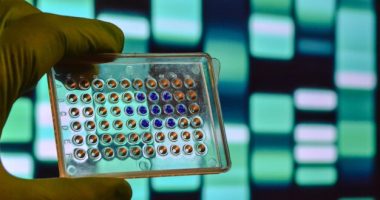Hepatocellular carcinoma (HCC), the most common type of liver cancer, presents significant therapeutic challenges due to its resistance to conventional treatments and its complex biological heterogeneity. Recent research focusing on TRIM34 targeting in hepatocellular carcinoma has unveiled promising strategies that might overcome these barriers, potentially revolutionizing how this malignancy is treated. A pivotal study conducted by Feifan Yao and colleagues has leveraged the capabilities of the CRISPR/Cas9 gene-editing technology to explore the genetic underpinnings of ferroptosis resistance—a type of programmed cell death—within HCC cells.
This breakthrough study identifies TRIM34, a relatively understudied protein, as a key factor in mediating resistance to ferroptosis in HCC. By conducting whole-genome CRISPR/Cas9 screens using erastin, a known inducer of ferroptosis, at subtoxic concentrations within Huh7 HCC cells, the researchers established that inhibiting TRIM34 can significantly enhance the cells’ sensitivity to ferroptosis. The implications of these findings are substantial, as enhancing ferroptosis sensitivity can directly impact HCC’s proliferative and invasive capacities.
Additionally, the study delves into the mechanism by which TRIM34 influences ferroptosis, illustrating its interaction with Up-frameshift 1 (UPF1), an essential component of the nonsense-mediated mRNA decay (NMD) pathway. The interaction between TRIM34 and UPF1 facilitates the ubiquitination and subsequent degradation of UPF1, which decreases the degradation of GPX4 mRNA, thereby stabilizing GPX4 protein levels. Since GPX4 is a vital suppressor of ferroptosis, its stabilization promotes resistance to cell death, contributing to the malignancy’s worsening prognosis.
Beyond its role in ferroptosis, TRIM34’s inhibition also appears to expand the therapeutic potential of immunotherapies like anti-PD-1 treatments. The study provides compelling evidence that knocking down TRIM34 in HCC cells enhances their response to immune checkpoint inhibitors, paving the way for possible combinatory therapies that could better manage or potentially cure HCC.
Conclusively, the research conducted by Yao and her team positions TRIM34 as a critical target in the development of future therapies for hepatocellular carcinoma. This could lead to innovative treatment strategies that modulate ferroptosis and improve immune responses, offering new hope to HCC patients worldwide.
### Background
Hepatocellular carcinoma (HCC) is the predominant form of liver cancer and constitutes a major health burden globally. Despite advances in oncology, HCC remains particularly challenging to treat due to its typically late diagnosis, frequent recurrence, and resistance to standard chemotherapeutic agents. The prognosis for patients with advanced HCC is often poor, underscoring the urgent need for innovative therapeutic strategies. One such emerging strategy is TRIM34 targeting in hepatocellular carcinoma, which represents a novel approach in the battle against this aggressive disease.
HCC arises predominantly in the context of chronic liver diseases, particularly those driven by hepatitis B and C infections, alcohol consumption, and non-alcoholic fatty liver disease. The complex etiology of HCC, combined with its genetic diversity, contributes to the variability in tumor behavior and response to treatment. Over the years, research has shifted from conventional chemotherapy to more targeted therapies and immunotherapy approaches, focusing on the molecular and genetic underpinnings of the tumor.
The discovery of TRIM34 as a potential target in HCC therapy is particularly significant. The TRIpartite Motif (TRIM) family of proteins, to which TRIM34 belongs, is known for its roles in various cellular processes including apoptosis, cell cycle regulation, and innate immunity. Recent studies have started to unfold the function of various TRIM proteins in cancer, hinting at their potential as therapeutic targets.
In the context of hepatocellular carcinoma, TRIM34’s role appears to be multifaceted. The key breakthrough came with the identification of TRIM34’s involvement in regulating ferroptosis, a type of programmed cell death distinct from apoptosis. Ferroptosis is iron-dependent and characterized by the accumulation of lethal lipid peroxides. It is induced by various stressors and has been speculated to play a role in cancer biology and resistance to therapies.
The study by Feifan Yao and colleagues utilized CRISPR/Cas9 technology—specifically, whole-genome CRISPR/Cas9 screens with erastin, a known inducer of ferroptosis. Their research showed that knocking down TRIM34 in HCC cells increased their sensitivity to ferroptosis. This finding is critical as it suggests that TRIM34 helps HCC cells resist ferroptosis, contributing to the cancer’s resistance to certain therapies and its aggressive nature.
The mechanism proposed involves the interaction between TRIM34 and Up-frameshift protein 1 (UPF1), which is part of the nonsense-mediated mRNA decay (NMD) pathway, a cellular mechanism that controls the degradation of mRNA molecules. TRIM34 was found to facilitate the ubiquitination and degradation of UPF1, reducing NMD efficiency. This decrease in UPF1 levels results in reduced degradation of GPX4 mRNA, thereby stabilizing the GPX4 protein that acts as a key suppressor of ferroptosis.
Further extending the implications of this discovery, the study also illustrated that inhibiting TRIM34 enhances the efficacy of anti-PD-1 immunotherapy in HCC models. These results suggest a dual benefit of TRIM34 targeting in HCC by not only sensitizing cells to ferroptosis but also enhancing the tumor’s response to immunotherapy.
The potential for TRIM34 targeting in hepatocellular carcinoma is significant, offering a dual-pathway therapeutic strategy that could be revolutionary. The research paves the way for the development of TRIM34 inhibitors or related compounds that might be used alone or in combination with existing therapies such as immunotherapies to create more effective treatment protocols for HCC. As with any emerging therapy, the translation of TRIM34 targeting from bench to bedside will require extensive clinical trials to validate these findings and to determine the safety, efficacy, and applicability of such treatments in diverse patient populations.
### Methodology
#### Study Design
The study conducted by Feifan Yao and colleagues exploring TRIM34 targeting in hepatocellular carcinoma was designed with the aim of understanding the role of the TRIM34 protein in mediating resistance to ferroptosis in hepatic cancer cells. The research utilized a coherent and multifaceted approach combining genetic screens, biochemical assays, and therapeutic intervention strategies to elucidate the mechanisms and therapeutic potential of inhibiting TRIM34 in HCC.
#### Genetic Screening Using CRISPR/Cas9
The core of the methodology was based on whole-genome CRISPR/Cas9 knockdown screens. This approach allowed for the systematic identification of genes that, when lost, enhance the sensitivity of HCC cells to ferroptosis. The research team employed the CRISPR/Cas9 system to generate a library of Huh7 HCC cells, each line harboring a knockout mutation for a different gene, covering essentially the entire genome. The gene-editing efficiency was optimized to ensure high knockout completeness.
For the screening, the cells were treated with subtoxic concentrations of erastin, a well-known ferroptosis inducer. This setup aimed to specifically highlight those genes that, when deactivated, lead to increased ferroptosis sensitivity rather than general cytotoxicity. The cell viability was assessed using standard MTT assays and cell counting, while next-generation sequencing was employed to identify which genes were knocked out in the surviving cell populations.
#### Biochemical and Interaction Studies
Upon identifying TRIM34 as a critical mediator of ferroptosis resistance via the genetic screens, the study proceeded to explore the biochemical pathways involved. This phase included co-immunoprecipitation assays and mass spectrometry to detect and verify interactions between TRIM34 and UPF1, suggesting a novel mechanistic insight into how TRIM34 regulates ferroptosis.
Western blotting and quantitative PCR were used to measure the levels of UPF1, GPX4 mRNA, and GPX4 protein in cells with and without TRIM34 expression. These experiments were fundamental in illustrating how TRIM34 affects the nonsense-mediated mRNA decay pathway and consequently the stabilization of GPX4, a central regulator of ferroptosis.
#### Therapeutic Intervention and Immunotherapy Enhancement
Further exploring the therapeutic potential of TRIM34 inhibition, the study assessed the effect of TRIM34 knockdown on the efficacy of anti-PD-1 immunotherapy. For these experiments, HCC models (both in vitro and xenograft mouse models) were used where TRIM34 was either knocked down or inhibited using small-molecule inhibitors developed based on the earlier findings.
Flow cytometry and immunohistochemistry were conducted to evaluate the immune response, particularly the activity and prevalence of PD-1 expressing cells in the tumor environment. These studies aimed to provide a comprehensive view of how TRIM34 targeting could boost the immune response and enhance the effectiveness of existing immunotherapies.
#### Analysis and Validation
Each experimental phase was carefully controlled, and results were validated through replicate experiments and controls. Statistical analyses were performed using software like GraphPad Prism to ensure the robustness of the conclusions drawn. Importantly, all findings were compared against relevant external data, and analogous studies to confirm validity and uniqueness of the research outcomes.
### Conclusion
In summary, the methodology employed in studying TRIM34 targeting in hepatocellular carcinoma was comprehensive and robust, integrating advanced genetic technologies with detailed biochemical and therapeutic evaluations. This rigorous approach not only confirmed TRIM34 as a viable target for enhancing ferroptosis and immunotherapy response in HCC but also set a precedent for future research avenues in targeted cancer therapies.
### Findings
The recent findings exploring TRIM34 targeting in hepatocellular carcinoma (HCC) offer promising insights into overcoming the challenges associated with treating this aggressive form of liver cancer. This innovative approach, highlighted chiefly through the efforts of Feifan Yao and colleagues, has brought to light the significant role TRIM34 plays in mediating resistance to ferroptosis, a form of programmed cell death crucial for cancer therapy management.
The pivotal discovery in this research was identifying TRIM34 as a regulator that helps HCC cells evade ferroptosis. By systematically knocking out genes using CRISPR/Cas9 technology in a library of Huh7 HCC cells and treating these with erastin, the researchers found that the absence of TRIM34 led to increased ferroptosis sensitivity. The experiments demonstrated that, in cells lacking TRIM34, there was a pronounced vulnerability to erastin-induced ferroptosis, manifesting in decreased cell viability compared to control groups where TRIM34 was active.
Further biochemical assays revealed the mechanism underlying TRIM34’s role: the protein interacts with Up-frameshift 1 (UPF1), a key factor in the nonsense-mediated mRNA decay (NMD) pathway. The interaction results in the ubiquitination and degradation of UPF1, leading to diminished NMD efficiency. The decreased degradation of GPX4 mRNA, consequent upon reduced UPF1, results in higher levels of GPX4 protein, a well-known suppressor of ferroptosis. This mechanism essentially confirms the hypothesis that TRIM34’s modulation of the NMD pathway contributes to the stabilization of GPX4 levels, thereby aiding in the resistance to cell death by ferroptosis.
Moreover, the LINK between TRIM34 expression and the efficacy of immunotherapy in HCC was also explored. The results demonstrated a noteworthy improvement in the response of HCC cells to anti-PD-1 therapy when TRIM34 was knocked down or inhibited. This aspect of the study posits TRIM34 as a dual-target molecule, not only important in the ferroptosis resistance pathway but also as a modulator of immune response. By enhancing the sensitivity of HCC cells to immunotherapy through TRIM34 inhibition, there is a two-pronged therapeutic approach to potentially tackling HCC more effectively.
The study extensively employed advanced methodologies such as co-immunoprecipitation, mass spectrometry, Western blotting, and quantitative PCR to corroborate the interactions and effects at the molecular level. Each experiment was conducted with the precision necessary for validating the role of TRIM34 in the targeted pathways. Additionally, the use of xenograft mouse models served to bridge the in vitro findings with in vivo scenarios, lending greater credence to the potential clinical applicability of TRIM34 targeting in hepatocellular carcinoma.
These findings, therefore, not only highlight a novel therapeutic target in TRIM34 but also expand the arsenal against HCC by potentially sensitizing tumors to ferroptosis-inducing drugs and enhancing the response to immune checkpoint inhibitors. The research opens up new avenues for combination therapies that could involve TRIM34 inhibitors together with ferroptosis-inducing agents and immunotherapies.
In conclusion, TRIM34 targeting in hepatocellular carcinoma represents a cutting-edge therapeutic strategy that could revolutionize the treatment landscape for HCC. The dual impact of TRIM34 modulation—both in promoting ferroptosis and enhancing immunotherapy efficacy—provides a powerful pathway that could be harnessed for developing more effective treatments for liver cancer, thus offering new hope to patients suffering from this malignancy.
### Future Directions and Final Thoughts on TRIM34 Targeting in Hepatocellular Carcinoma
The groundbreaking research on TRIM34 targeting in hepatocellular carcinoma marks a significant advancement in our understanding and management of this lethal cancer. As the studies by Feifan Yao and colleagues have shown, targeting TRIM34 could potentially alter the treatment landscape for hepatocellular carcinoma by enabling two distinct but complementary therapeutic pathways: enhancing ferroptosis and boosting the efficacy of immunotherapies.
#### Expanding Research Horizons
Future research should focus on developing specific inhibitors of TRIM34 that can be safely and effectively used in clinical settings. The production of small-molecule inhibitors or monoclonal antibodies that can specifically block the TRIM34-UPF1 interaction may provide a direct route to facilitating greater ferroptosis in HCC cells. Investigating the pharmacokinetics, pharmacodynamics, and optimal dosing schedules of such inhibitors will be crucial.
Moreover, further studies are needed to understand the full spectrum of TRIM34’s role in different subtypes of HCC, which may vary in their genetic makeup and etiological factors. Understanding these variations could lead to more personalized approaches in the treatment of liver cancer.
#### Clinical Trials and Beyond
The transition from bench to bedside, involving rigorous clinical trials, is the next logical step. These trials will need to evaluate the efficacy and safety of TRIM34 inhibitors in humans, and determine their compatibility with existing treatments. Considering the interaction of TRIM34 with immune checkpoint inhibitors, trials should also explore combination therapies that could potentially enhance the immune-mediated eradication of tumor cells.
Additionally, as research progresses, the potential for resistance mechanisms against TRIM34 targeting must also be anticipated. Monitoring and analyzing any emerging resistance will help in iterating the therapeutic approaches to stay effective against the adaptive nature of cancer.
#### Multifaceted Therapeutic Strategies
The idea of using TRIM34 targeting in combination with other therapeutic strategies is particularly promising. Combining TRIM34 inhibitors with drugs that induce ferroptosis or with other forms of chemotherapy and targeted therapies could yield synergistic effects, potentially overcoming the notorious resistance of HCC to conventional treatments.
#### Global Health Implications
Given the high incidence of hepatocellular carcinoma in regions afflicted by hepatitis B and C viruses, research and subsequent treatments need to be accessible in these areas. Collaborations between researchers, governments, and international health organizations will be essential to ensure that advancements in TRIM34 targeting therapies are available globally, especially in low-resource settings.
#### Ethical and Regulatory Considerations
As with any new treatment strategy, ethical and regulatory considerations must be carefully navigated. Ensuring patient consent, understanding the long-term implications of gene-editing technologies, and navigating the regulatory pathways for novel treatments will be essential parts of bringing TRIM34 targeting therapies to the clinic.
### Conclusion
TRIM34 targeting in hepatocellular carcinoma represents a novel and exciting frontier in cancer therapy. The dual function of TRIM34, influencing both cell death pathways and immune responses, poses a unique opportunity for comprehensive disease management. While there are numerous steps ahead, from further research to clinical trials, the potential impact on patient outcomes could be profound. Collaborative and well-supported scientific inquiry into TRIM34 could change the prognosis for those suffering from this challenging malignancy, ultimately offering new hope and enhanced therapeutic options for hepatocellular carcinoma patients worldwide.
No references available in the original article.








